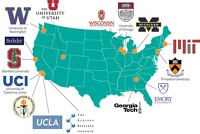Advertisement
Grab your lab coat. Let's get started
Welcome!
Welcome!
Create an account below to get 6 C&EN articles per month, receive newsletters and more - all free.
It seems this is your first time logging in online. Please enter the following information to continue.
As an ACS member you automatically get access to this site. All we need is few more details to create your reading experience.
Not you? Sign in with a different account.
Not you? Sign in with a different account.
ERROR 1
ERROR 1
ERROR 2
ERROR 2
ERROR 2
ERROR 2
ERROR 2
Password and Confirm password must match.
If you have an ACS member number, please enter it here so we can link this account to your membership. (optional)
ERROR 2
ACS values your privacy. By submitting your information, you are gaining access to C&EN and subscribing to our weekly newsletter. We use the information you provide to make your reading experience better, and we will never sell your data to third party members.
Synthesis
Trailblazing Collaborations
by Bibiana Campos Seijo
February 22, 2016
| A version of this story appeared in
Volume 94, Issue 8
Back in October, C&EN’s first monthly Perspectives column focused on collaborations in the field of organic chemistry. The authors of that opinion piece, Huw M. L. Davies and Daniel Morton of the Center for Selective C–H Functionalization (CCHF), told us how a new approach to organic synthesis collaboration was helping shift the discipline from a fiercely competitive environment to a more diverse and collaborative atmosphere in which researchers share and exchange ideas and work toward common goals. This new approach eventually grew into CCHF, an NSF-funded Center for Chemical Innovation that is made up of more than 23 research groups spread over 15 institutions from across the U.S.
Davies and Morton say that CCHF facilitates “an exciting and vibrant intellectual environment” where scientists from a broad range of disciplines address some of the big questions in C–H functionalization. It provides the means to address challenges that would be impossible for groups to consider individually, so it is a situation where the whole is greater than the sum of its parts. It’s clear that this area will profit from the presence of CCHF, and it won’t take long for other chemistry disciplines to follow suit and establish similar networks.
Aside from networks such as CCHF, however, it is still unusual for collaboration to happen spontaneously between two groups in a field where teams are competitive. But the C–H functionalization field is again blazing the trail, and I’d like to invite you to take a look at a paper just published by the Journal of the American Chemical Society (2016, DOI: 10.1021/jacs.5b13586).
The paper describes the work carried out by researchers led by Indiana University’s M. Kevin Brown and Baylor University’s John L. Wood on the synthesis of hippolachnin A. Hippolachnin A is a natural product with antifungal properties that has been recently isolated from the marine sponge Hippospongia lachne.
The Brown and Wood groups had been working independently toward the synthesis of hippolachnin A when they became aware of each other’s work at the 2015 National Organic Chemistry Symposium. They found out that their approaches had great similarities (both used quadricyclane as starting material and employed late-stage C–H oxidation) and complementary strengths, and they decided to collaborate for the benefit of both groups.
They agreed to devise their routes independently and then select the best aspects of each one to prepare the compound in the shortest, most efficient way. The synthesis benefits from the early stages of the Brown route and the later stages of Wood’s. The Brown route provides insight into the electronics required for cycloaddition chemistry of the quadricyclane substrate and broadens the scope of C−H oxidations involving alcohols. The Wood route exploits Lewis-acid-promoted reactions of quadricyclane and highlights the importance of adventitious water in some applications of C−H oxidation chemistry. The net result is three more synthetic pathways for the production of hippolachnin A, each producing advances in different areas of synthesis.
This is work that stands out on the merits of the chemistry alone. But it goes beyond that by demonstrating the benefits of outstanding collegiality within the field. As the authors state, “A productive scientific community is one that recognizes the importance of research driven by the interests and passion of individual investigators while at the same time fostering collaborative efforts.” Whether they happen through networks such as CCHF or in similar fashion to the Brown-Wood example described here, collaborations are vital for the advancement of science and, if nothing else, show great leadership and trust among scientists—the signs of a healthy environment for science to thrive.
Views expressed on this page are those of the author and not necessarily those of ACS.





Join the conversation
Contact the reporter
Submit a Letter to the Editor for publication
Engage with us on Twitter